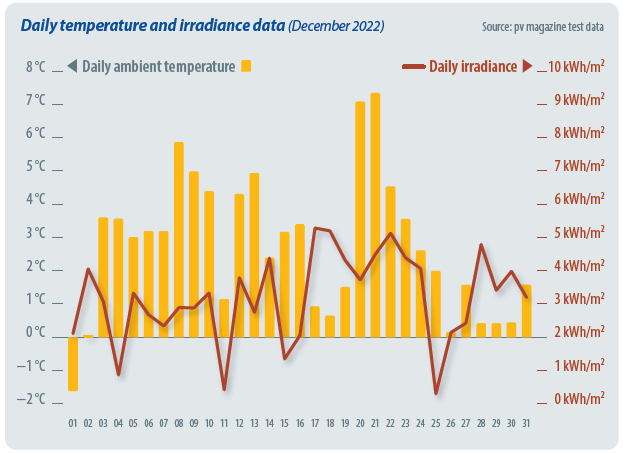pv magazine test: June 2024 Results
By George Touloupas
This article was originally published in pv magazine – June 2024 edition. Learn more about the pv magazine test here.
George Touloupas, Senior Director of Technology and Quality for Clean Energy Associates (CEA), analyzes the June 2024 results from the pv magazine test outdoor installation in Xi’an, China.
Some data has been removed, due to a power cut on June 22 to 23 and the installation of three new bifacial, tunnel oxide passivated contact (TOPCon) products from AE, Trina and DEMGC in the outdoor test field in early June. The first chart shows the meteo station data (irradiance and ambient temperature) for June 2024.
Figure 1: Daily temperature and irradiance data - June 2024
The three new TOPCon samples performed very well in their first month, resulting in a higher bifacial boost for TOPCon than heterojunction (HJT), which is only represented by two products. However, it is too early to say that TOPCon performs better than HJT, as we need more time and more HJT products to draw conclusions. Meanwhile, as summer progresses and high temperatures prevail, the improved power temperature of TOPCon and HJT panels are contributing to the higher performance compared to passivated emitter and rear contact (PERC).
Table 1: Bifacial boost - March 2024 to June 2024
Table 2: Specific energy-yield ranking of n-type bifacial (TOPCon and HJT) modules - June 2024
Table 3: Specific energy-yield ranking of bifacial PERC modules - June 2024
Table 4: Specific energy-yield ranking of monofacial modules - June 2024
Energy yield measurements
The energy yield comparison among various technologies, including bifacial boost, is analyzed using products installed after the beginning of 2019.
The energy yield is given in Wh/Wp and calculated by dividing the energy produced by the module by the Pmax at STC of the module. This Pmax is the maximum STC power after a process of stabilization.
The results are grouped into categories, per solar module type.
The bifacial boost depends on a number of parameters: the bifaciality factor, the installation geometry, the albedo of the ground, the sun angle, and diffuse irradiance. The ground in this case is gray gravel.
Figure 2: Specific energy yield of n-type bifacial (TOPCon and HJT), bifacial PERC, and monofacial modules - June 2024
Figure 3: Relative yield of different technologies - June 2024
Test cooperation
pv magazine test is a cooperative effort involving pv magazine, CEA, Gsola and Hoymiles. All testing procedures are carried out at Gsolar’s test laboratory in Xi’an, China. CEA supervises these tests and designed both the indoor and outdoor testing procedures.


































